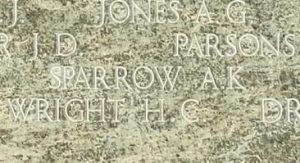Guilsfield is a village in Montgomeryshire, situated on the B4392 road, some two and a half miles north of Welshpool. The village has ancient origins, dating back to the Bronze Age, and contains several large country estates, notably Maesmawr Hall and Trawscoed Hall. The men of the village who fell during both World Wars are commemorated on the Parish War Memorial, which is situated within the Churchyard of Saint Aelhaiarn’s Church. The memorial takes the form of a stone cross which sits on an octagonal base, which bears the names of the fallen.
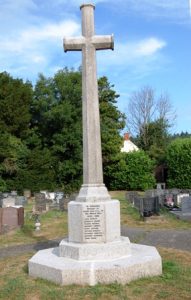
The Great War, 1914-1918
John Thomas Allsopp, Gunner, W/4857, Royal Field Artillery. John was the son of Thomas and Hannah Allsopp, of Derby. He came to Guilsfield to work as a groom and married Louisa Rogers, of the Old Post Office, Guilsfield on 27 February 1905. John enlisted at Chester into the Welsh Divisional Royal Field Artillery soon after the outbreak of war. John was then posted to C Battery, 119th Brigade, Royal Field Artillery, which was attached to the 38th (Welsh) Division. The Division moved to France in December 1915 and moved to the Nursery Sector near Fleurbaix for trench initiation alongside the Guards Division. The Division then held a sector of the line near Cuinchy before marching south to the Somme sector in June 1916 to take part in the assault on Mametz Wood. The first attack on the wood was launched on a two-battalion front on 7 July, but failed, and the Divisional Commander, Sir Ivor Philipps, was replaced before the Division attacked again on a two Brigade front on 10 July 1916. After two days of ferocious hand-to-hand fighting, the wood was cleared up to its northern edge, before the battered Division was relieved. It then took over a section of the front at Hébuterne before moving to the Ypres Salient, and taking over the Canal Bank sector at Boesinghe. The infantry battalions of the Division then began carrying out the normal pattern of rotation in the trenches, four days in the front, four in support and four in reserve, whilst also working on trench improvement, digging new trenches, and also carrying out regular patrols and trench raids. Over the coming months the men of the Division worked hard, preparing for the forthcoming Third Battle of Ypres. During the early hours of 1 June 1917, C Battery was situated at a position behind the lines called Trois Rois when it came under fire from a German long-range 15cm gun. John and another man were killed, and a number of men were buried in a dugout. John was 40 years old when he was killed that morning and is buried in Bedford House Cemetery, Belgium. John is not commemorated on the Guilsfield war memorial.
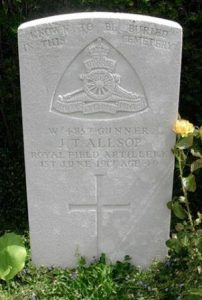
Evan Arthur, Driver, 449663, Royal Engineers. Evan was the son of Francis and Edith Arthur, of White House, Moelgarth, Guilsfield. He worked as a cowman prior to enlisting into the 7th Battalion, Royal Welsh Fusiliers at Welshpool, but at some time later was medically downgraded and was transferred to the Royal Engineers. He most probably served with one of the RE units attached to the 53rd (Welsh) Division, so would have seen service in Palestine. Evan returned to Britain after the Armistice and was on leave at home when he became ill and died of pneumonia on 7 March 1919. The 21-year-old is buried in Guilsfield Cemetery. His brother, Francis, was killed in Palestine in 1917. Evan is not commemorated on the Guilsfield war memorial.
Francis Arthur, Private, 290819, Royal Welsh Fusiliers. Francis was the son of Francis and Edith Arthur, of White House, Moelgarth, Guilsfield. He worked as a timber haulier prior to enlisting into the 7th Battalion, Royal Welsh Fusiliers at Welshpool on 9 November 1914. He was posted to the 3/7th Battalion, Royal Welsh Fusiliers, one of the reserve battalions, at Park Hall Camp, Oswestry for training. On 27 January 1916 Francis embarked at Devonport for Egypt, joining the 1/7th Battalion, Royal Welsh Fusiliers, which was attached to 158 Brigade, 53rd (Welsh) Division. The Division had been evacuated from Gallipoli in December 1915, moving to Egypt to join the EEF, and helped guard the Suez Canal before taking part in operations to drive the Turks out of the Sinai. The EEF then turned its attention onto driving the Turks out of Palestine, and on 26 March 1917 launched its first offensive against the coastal city of Gaza, which guarded the road to Jerusalem. Initial gains during the day were lost when the assaulting divisions lost touch with each other, and communication broke down when a thick fog cloaked the battlefield. A second attempt to force Gaza was launched on 17 April, which also failed, and the EEF suffered a change in leadership, with Sir Edmund Allenby assuming command, before being re-organised, and a third offensive was launched against a wider front from Beersheba to Gaza on 31 October 1917. This time the Turkish defences were breached, and the road to Jerusalem now lay open and the EEF began to advance north. Francis was killed, probably by a sniper, during the Divisions advance to the foothills of the Khuweilfeh range on 4 November 1917. The 21-year-old has no known grave and is commemorated on the Jerusalem Memorial, Israel. His brother, Evan, died on active service in 1919.
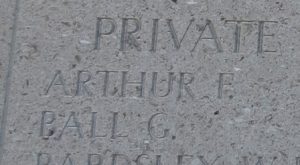
David Thomas Bailey, Lance Corporal, 35047, Cheshire Regiment. David was the son of John Thomas Bailey and Mary Bailey (nee Morris), of Brook House, Cloddia, Guilsfield. He lived at 99 Rodney Street, Birkenhead prior to the war and worked as a plumber for J. Davies at Heswall. David enlisted into the 14th Battalion, Cheshire Regiment at Birkenhead on 21 November 1915 and was initially placed on the Army Reserve. He was mobilised on 15 February 1916 and joined the battalion at Prees Heath, near Whitchurch. On 19 July 1916 David embarked for France and joined the Infantry Base Depot at Rouen. On 27 July 1916 he was posted to the 13th Battalion, Cheshire Regiment, which was on the Somme attached to 74 Brigade, 25th Division. David joined the 13th Cheshire’s at Mailly Wood, just prior to the battalion going into the trenches at Mary Redan on 31 July. Apart from the constant threat from German minenwerfer fire, the battalion enjoyed a relatively quiet tour in the line over the coming days before being relieved and marching to billets in Beaussart. It was not until 18 August that the 13th Cheshire’s took over the front line again, moving to the Thiepval Wood sector and suffered another spell of constant German minenwerfer fire over the coming days. On 27 August the battalion marched out of the line to bivouacs at Bouzincourt Ridge, then by 1 September moved into a new section of the line at Ovillers. The 13th Cheshire’s then spent the coming weeks in a similar rotation until 20 October, when the battalion moved into Hessian Trench, preparatory for an assault on the following morning. At dawn on 21 October 1916, the 13th Cheshire’s took part in an assault by 74 Brigade upon the strongly defended Regina Trench. Over 250 prisoners were taken by the battalion, but at the cost of almost 200 casualties. David had been killed during the assault. The 26-year-old is buried in Stump Road Cemetery, Grandcourt, France. His younger brother, Herbert, was killed in France two years later.
Herbert Bailey, Private, 26842, Duke of Wellington’s (West Riding Regiment). Herbert was the son of John Thomas Bailey and Mary Bailey (nee Morris), of Brook House, Cloddia, Guilsfield. He enlisted at Welshpool into the 7th Battalion, Royal Welsh Fusiliers on 12 October 1914 and was posted to the 2/7th (Reserve) Battalion, Royal Welsh Fusiliers. Herbert embarked for France on 31 July 1916, joining the 5th Infantry Base Depot at Rouen. A week later he was posted to the 17th Battalion, Royal Welsh Fusiliers, which was attached to 115 Brigade, 38th (Welsh) Division. The Division had just been relieved from the Somme sector, following its assault on Mametz Wood the previous month, and Herbert joined the 17th RWF in billets at Volkerinkhove, where it was refitting following heavy losses. The Division then moved to the Ypres Salient, taking over the Canal Bank sector at Boesinghe. The infantry battalions of the Division then began carrying out the normal pattern of rotation in the trenches, four days in the front, four in support and four in reserve, whilst also working on trench improvement, digging new trenches, and also carrying out regular patrols and trench raids. On 31 July 1917 the Division launched its famous assault on the Pilckem Ridge, capturing Iron Cross and reaching its objective of the Steenbeek, then played a supporting role in the Battle of Langemarck. Herbert was wounded during the assault on Pilckem Ridge and was hospitalised at Boulogne before being evacuated home aboard the Hospital Ship St. Denis. Upon his recovery, he embarked for France again on 9 December 1917 and disembarked at Rouen, before being posted to the 19th Battalion, Royal Welsh Fusiliers, which was in the Bullecourt Sector, attached to 119 Brigade, 40th (Bantam) Division. On 6 February 1918 the battalion was disbanded, following the reorganisation of the army in France and Herbert was temporarily posted to the 8th Entrenching Battalion. On 6 April 1918 he was transferred to the 1/6th Battalion, Duke of Wellington’s (West Riding Regiment), which was at Ypres attached to 147 Brigade, 49th (West Riding) Division. During June 1918 he was hospitalised at the 16th General Hospital at Le Treport, after contracting influenza, then re-joined the battalion at Zillebeke Lake, in the Ypres Salient, on 24 July. To the south, on 21 August 1918 the Allies launched a general assault along a long stretch of the front and began to drive the Germans back towards the Hindenburg Line. The 49th Division was relieved from Ypres and transferred south to join the great offensive, reaching Estrée-Cauchy, north-west of Arras, by 1 September and began a scheme of training. It was not until the beginning of October that the Division moved forward to take part in the offensive, moving to the old Drocourt-Queant line and then marched forward to positions at Escaudouvres, north of Cambrai, to take part in the pursuit of the Germans to the River Selle. On 11 October 1918 the Division attacked from its starting positions at Navres, just northeast of Cambrai, alongside the Canadian Corps. Herbert was killed in action during the initial assault that day. The 21-year-old is buried in Wellington Cemetery, Rieux-En-Cambresis, France. His elder brother, David, had been killed in France two years earlier.
William Edward Breeze, Private, 290821, Royal Welsh Fusiliers. William was the son of David Abraham Breeze and Jane Breeze (nee Lewis), of Groeslwyd, Guilsfield. He worked as a gardener prior to enlisting into the 7th Battalion, Royal Welsh Fusiliers at Welshpool on 9 November 1914. The battalion was a Territorial unit, which mobilised for war at Newtown in August 1914, as part of North Wales Brigade, Welsh Division and moved to Conway until the end of the month, before moving to Northampton. In December the Division moved to Cambridge and then in May 1915 to Bedford, where the Division was numbered and the formation became 158 Brigade, 53rd (Welsh) Division. On 19 July 1915 the entire Division sailed from Devonport for Imbros and on 9 August 1915 landed at Suvla Bay. The infantry moved off the beaches across the Salt Lake, under shellfire, into the scrub covered Chocolate Hill, but due to a lack of maps and no knowledge of the terrain, many of the units became disorientated, and the situation became chaotic. The Division was eventually evacuated from Gallipoli in December 1915, moving to Egypt to join the EEF, and helped guard the Suez Canal before taking part in operations to drive the Turks out of the Sinai. The EEF then turned its attention onto driving the Turks out of Palestine, and on 26 March 1917 launched its first offensive against the coastal city of Gaza, which guarded the road to Jerusalem. Initial gains during the day were lost when the assaulting divisions lost touch with each other, and communication broke down when a thick fog cloaked the battlefield. A second attempt to force Gaza was launched on 17 April, which also failed, and the EEF suffered a change in leadership, with Sir Edmund Allenby assuming command, before being re-organised, and a third offensive was launched against a wider front from Beersheba to Gaza on 31 October 1917. This time the Turkish defences were breached, and the road to Jerusalem now lay open and the EEF began to advance north. On 6 November 1917, 158 Brigade launched an attack on the Khuweilfeh Heights, and once secured, the EEF continued its advance into the Judean Hills, the 53rd Division capturing Hebron and Bethlehem, before securing the Jerusalem to Jericho Road. Allenby finally made his triumphant entry into Jerusalem on 11 December. Over the following months the EEF continued to advance northwards through the Jordan Valley, before Turkey capitulated on 30 October 1918. Sadly, William did not live to see the Armistice with Turkey. He had taken ill just a few weeks previously and died of pneumonia in hospital at Ramleh on 28 October 1918. The 23-year-old is buried in Ramleh War Cemetery, Israel. William is not commemorated on the Guilsfield war memorial.
Ernest Chorlton, Private, 54394, Royal Welsh Fusiliers. Ernest was the illegitimate son of Mary Ellen Burgess, of Traws-Coed Cottage, Guilsfield. His mother married Frederick Chorlton, a warehouseman, at Manchester on 3 August 1903. Ernest was raised by his grandparents as Ernest Burgess but enlisted into the Montgomeryshire Yeomanry under his stepfather’s name as Ernest Chorlton. As soon as he turned 18, Ernest embarked for France in the summer of 1916 and was posted to the 10th Battalion, Royal Welsh Fusiliers, which was on the Somme attached to 76 Brigade, 3rd Division. The battalion had taken a mauling during its assault on Delville Wood on 20 July 1916, where it became caught in terrible fighting within the wood, the fighting of such severity that two men of the battalion were awarded the Victoria Cross. On 25 July the shattered battalion was relieved and moved into reserve and did not move back into the line until 17 August, when the battalion attacked Lonely Trench. On 23 August the Division moved out of the line to rest and moved to Noeux-les-Mines, near Loos. After a month there, the Division moved back into a rest area for further training before moving back south to the Somme and by 12 November took over trenches at Serre. On the following day, 13 November 1916, the Division launched an assault against the German positions at Serre. The 10th RWF reached Serre village, but the flanking battalions failed to keep up, and heavy losses were suffered, with almost 300 officers and men killed, wounded, or missing. Ernest was probably taken prisoner during the assault on Serre and was taken to a Prisoner of War Camp at Munster Lage, Germany, where he died of ill-health on 18 May 1917. The 18-year-old is buried in Hamburg Cemetery, Germany. His stepfather, Frederick Chorlton, was killed in action during the opening day of the Battle of the Somme, on 1 July 1916.
Frederick Chorlton, Lance Corporal, 17585, Royal Scots. Frederick was born at Withington, Manchester in 1879, the son of John and Frances Chorlton. He married Mary Ellen Burgess, of Traws-Coed Cottage, Guilsfield, at Manchester on 3 August 1903. Frederick had previously served with the Manchester Volunteer Artillery prior to enlisting into the army at Manchester on 4 October 1914 and was posted to Edinburgh, where he attested into the 15th Battalion, Royal Scots. The battalion had been raised in Edinburgh in September 1914 by the Lord Provost and City, before moving to Troon, then in June 1915 moved to Ripon, joining 101 Brigade, 34th Division. On 8 January 1916 the battalion landed at Le Havre and moved with the Division to the Erquinghem sector for trench initiation alongside the 23rd Division. By 14 April the Division had been relieved and moved to Eperlecques, then in May was sent to the Somme sector, taking over positions east of Albert. At dawn on 1 July 1916 the Division took part in its first major action, when it attacked the village of La Boiselle. Frederick was killed in action during the opening assault across No Man’s Land that day. The 37-year-old has no known grave and is commemorated on the Thiepval Memorial, France. The 34th Division suffered heavier losses during the day than any other Division. His widow, Mary Ellen and their two children had been living with Mary’s parents at Guilsfield since 1911, and his stepson, Ernest, died in Germany in 1917, but Frederick is not commemorated on the Guilsfield war memorial.
John William Edwards, Private, 18567, King’s Shropshire Light Infantry. John was the son of John Edwards and Sarah Edwards (nee Cheshire), of Croes, Guilsfield. He enlisted at Shrewsbury into the King’s Shropshire Light Infantry soon after the outbreak of war. John embarked for France on 22 December 1915, joining the 1st Battalion, King’s Shropshire Light Infantry. The battalion was at Ypres attached to 16 Brigade, 6th Division and was holding a sector of the line at Burgomaster Farm and the Canal Bank. On 25 February the Division moved to the Railway Wood and Hooge Sector, which it held for several weeks prior to returning to the Canal Bank Sector. The Division remained there until being relieved at the end of June 1916 and moved to the reserve area around Tatinghem. In the middle of July, the Division moved back into the line in the Potijze Sector, but its stay there was to prove very short-lived as during the opening days of August it was relieved and entrained south for the Somme, to join the great offensive there. The Division took over a section of the front line at Beaumont-Hamel on 15 August, while its various infantry battalions spent time behind the line at Naours, training, over the coming weeks. On 11 September the 1st KSLI moved back into the front line, taking up positions near Maricourt and on 15 September 1916 took part in a great assault on Morval, as part of the overall Battle of Flers-Courcelette. John was killed in action at Guillemont two days later, on 18 September 1916. The 21-year-old has no known grave and is commemorated on the Thiepval Memorial, France. John is not commemorated on the Guilsfield war memorial.
Edward Evans, Sergeant, 5519, Wiltshire Regiment. Edward was born in 1879, the son of Thomas and Mary Evans, of Guilsfield. Edward had moved to 22, Stuart Street, Treorchy as a young man, and worked as a coal miner. He married Mary Catherine Jones in 1908, and the couple had two children. Edward was probably an army reservist, who re-enlisted into the 1st Battalion, Wiltshire Regiment in London soon after the outbreak of war. The battalion was at Tidworth, attached to 7 Brigade, 3rd Division, and on 14 August 1914 Edward landed at Rouen with the battalion. The 3rd Division then moved to the Belgian Frontier, taking part in the opening Battle of Mons, and in the epic retreat, from the Rearguard Action of Solesmes, through the Battle of Le Cateau, and down to the Marne, where the German Offensive was stopped. The Division followed the German withdrawal to the Aisne, where they met them in battle, and stopped the advance on Paris. The Division then moved north to Flanders, and took part in the Battle of La Bassée, and at the Battle of Messines, which were a prelude to the First Battle of Ypres. The Division took part in the famous Christmas Truce on 25 December 1914 and remained at Ypres throughout the winter. In 1915 the Division saw action at Bellewaarde and Hooge and took part in the Second attack on Bellewaarde. Edward must have been invalided home at some time, as he was later posted to the 5th Battalion, Wiltshire Regiment. The battalion was attached to 40 Brigade, 13th (Western) Division, and had taken part in the Gallipoli campaign, before being evacuated to Egypt in January 1916, and the following month was diverted to Mesopotamia, to take part in the attempt to relieve the besieged garrison at Kut. Edward was wounded soon after, during the failed attempt to rescue General Townshend’s garrison, and died of his wounds on 30 March 1917. The 38-year-old is buried in Baghdad (North Gate) War Cemetery, Iraq. Edward is not commemroated on the Guilsfield war memorial.
Edward Delme Evans, Private 55318, Welsh Regiment. Edward was born at Llandovery in 1897, the son of Edward and Jane Evans. The family, from Moelygarth, was living at 14, Signal Terrace, Oswestry by 1901, and Edward’s father was working in the town as a clogger. By 1911 the family had moved to 8, Ash Road, Oswestry and young Edward worked for the Great Western Railway at Oswestry. He enlisted at Oswestry into the King’s Shropshire Light Infantry and after completing his training was drafted to France in the summer of 1917, joining the 2nd Battalion, Welsh Regiment, which was attached to 3 Brigade, 1st Division. The Division had followed the German withdrawal to the Hindenburg Line in March 1917, then the 2nd Welsh spent several weeks undergoing training and rebuilding at Chuignes and Rouy-les-Grand before moving to Roisel by 27 April and Flêtre by the beginning of June. Edward probably joined the 2nd Welsh at Flêtre on 8 June, just before the battalion moved to Dickebusch Lake, in the Ypres Salient with the 1st Division. The battalion then began supplying working parties in the St. Eloi sector, before the Division moved to Caestre on 16 June, preparatory to the entire Division being transferred to Le Clipon Camp, near Coxyde on the Flanders coast, to prepare for a possible offensive. The operation was cancelled when it became clear that the Passchendaele offensive had bogged down, so on 7 November 1917 the Division entrained for the Ypres Salient, taking over a section of the front line on Passchendaele Ridge the following day. On 10 November the 2nd Welsh took part in an assault against the ridge, but was forced to withdraw to Irish Farm. The battalion was relieved on the following day and marched back to Dambre Camp to rest, then on 15 November moved back into the front line near the Paddebeek. Edward was killed in action here by enemy shellfire on 17 November 1917. The 20-year-old has no known grave and is commemorated on the Tyne Cot Memorial, Belgium. The family later resided at Tanyard Row, Llansantffraid.
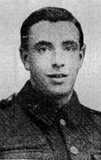
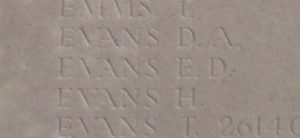
Fred Evans. Fred cannot presently be identified.
Robert Evans, Private, 54398, Royal Welsh Fusiliers. Robert was the son of William and Margaret Evans, of Lower Park, Guilsfield. He worked as a cowman at Great Hope, Leighton prior to the war. Robert enlisted at Welshpool into the Montgomeryshire Yeomanry and was probably posted to Park Hall Camp, Oswestry for training. During the summer of 1916 he was drafted to France and was posted to the 10th Battalion, Royal Welsh Fusiliers, which was attached to 76 Brigade, 3rd Division. The Division had suffered terrible casualties during its assault on Delville Wood on 10 July, in an action of such ferocity that the 10th RWF gained the award of two Victoria Crosses. On 25 July the shattered battalion was relieved and moved into reserve and did not move back into the line until 17 August, when the battalion attacked Lonely Trench. On 23 August the Division moved out of the line to rest and moved to Noeux-les-Mines, near Loos. After a month there, the Division moved back into a rest area for further training before moving back south to the Somme and by 12 November took over trenches at Serre. On the following day, 13 November 1916, the Division launched an assault against the German positions at Serre. The 10th RWF reached Serre village, but the flanking battalions failed to keep up, and heavy losses were suffered, with almost 300 officers and men killed, wounded, or missing. Robert was among the men killed in the attack that day. The 27-year-old has no known grave and is commemorated on the Thiepval Memorial, France.
Albert Edwin Frampton, Private, 14507, King’s Shropshire Light Infantry. Albert was born at Guilsfield in 1894, the son of John Philip Frampton and Mary Hannah Frampton (nee Bennett) and was baptised there on 2 December 1894. The family later moved to Melverley Crossing, Llanymynech after the death of Mary in 1910. Albert enlisted into the 7th Battalion, King’s Shropshire Light Infantry at Oswestry soon after the outbreak of war. The battalion had formed at Shrewsbury in September 1914, before joining 76 Brigade, 25th Division at Codford, Salisbury Plain. Albert must have taken ill soon after arriving at Salisbury Plain and was hospitalised at Bristol where he died on 11 December 1914. The 20-year-old is buried in Arnos Vale Cemetery, Bristol. Albert is not commemorated on the Guilsfield war memorial.
Robert Sandeman Gaisford, Captain, Royal Flying Corps. Robert was born at Guilsfield on 14 January 1896, the son of Lieutenant Colonel Douglas John Gaisford and Elizabeth Glencairn Gaisford (nee Alison). He was educated at Wellington College, and passed into the Royal Military Academy, Woolwich in September 1913. Robert passed out and was commissioned as Second Lieutenant into the Royal Field Artillery in September 1914. He embarked for France in May 1915 and took part in the Battle of Aubers Ridge soon afterwards. Robert then took part in the Battle of Loos on 25 September, and the following year fought during the Battle of the Somme. He volunteered for the Royal Flying Corps in 1917 and on 7 June 1917 gained his pilots certificate at the Military School, Ruislip. Robert was then posted to 34 Squadron, RFC. The Squadron had embarked for France in July 1916 as a reconnaissance unit equipped with BE2s, then in January 1917 it refitted with RE8s. Towards the end of 1917 it was sent to the Italian Front, to fly reconnaissance and bomber missions. On 30 January 1918 Robert was flying over enemy territory when his aircraft was shot down and crashed in flames, killing him and his observer. The 22-year-old was buried next to his observer in Tezze British Cemetery, Italy.
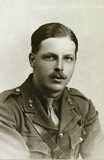
Charles Galliers, Private, 33246, King’s Shropshire Light Infantry. Charles was born at Guilsfield in 1895, the illegitimate son of Mary Emma Galliers. He was adopted by Edward and Annie Jones, of Guilsfield soon after his birth. By 1911 Charles was lodging at Severn Street, Welshpool, where he worked as a stableboy, but soon afterwards he moved to Oswestry after gaining work for the Cambrian Railways. He enlisted at Oswestry into the King’s Shropshire Light Infantry and was drafted to Egypt in the summer of 1917, joining the newly formed 10th Battalion, King’s Shropshire Light Infantry, which had formed at Cairo on 2 March 1917 from the merger of two dismounted yeomanry regiments, as part of 231 Brigade, 74th (Yeomanry) Division. The Division saw its first major action during the Second Battle of Gaza on 17 April. The battle was a failure, and the EEF was re-organised under a new commander, Sir Edmund Allenby, before launching the Third Battle of Gaza on the night of 31 October 1917. This assault was launched along a winder front, running from Gaza to Beersheba, and this time the EEF prevailed, opening the door to Jerusalem. The Division then took part in the drive north into Syria, but as a result of the heavy losses suffered in France, following the launching of the three German Spring offensives from 21 March 1918, was sent to France, landing in Marseilles on 7 May 1918. The Division underwent a system of training, to prepare it for the vastly different conditions on the Western Front, before taking over a section of the front in the St. Floris Sector. On 21 August 1918 the 10th KSLI relieved the 24th Welsh in the front line to begin a routine spell in the trenches. Charles was wounded during the relief and was evacuated to hospital at Merville, where he died of his wounds on 22 August 1918. The 22-year-old is buried in Merville Communal Cemetery Extension, France.
Arthur Gough, Private, 55214, Royal Welsh Fusiliers. Arthur was the son of William and Priscilla Gough, of Mea House, Guilsfield. He enlisted at Welshpool into the Montgomeryshire Yeomanry soon after the outbreak of war and was posted to park Hall Camp, Oswestry, joining their 1/3rd Battalion. Arthur was drafted to France in the winter of 1916-17, joining the 2nd Battalion, Royal Welsh Fusiliers, which was attached to 19 Brigade, 33rd Division. The battalion had suffered heavy casualties during the Somme, fighting for High Wood, during July and August 1916 before being relieved. During the coming weeks the 2nd RWF received several drafts of reinforcements, and on 8 December the now fully rebuilt battalion moved to new positions at Suzanne, between Bapaume and Péronne. The Division remained in this sector over the coming months, before being transferred to the Arras sector, and reached Henin by 13 April, before the Division took over a section of front line facing the Hindenburg Line. The infantry battalions of the division then began the usual routines of rotating between the front-line, support and reserve trenches and the 2nd RWF took over a position known as Tunnel Trench. On 23 April the 2nd RWF took part in a costly assault on the Hindenburg Line, suffering heavy casualties. The battered battalion then moved to a rest camp at Basseux to rebuild, and by 15 May moved back into the line in the Croisilles Sector. The Division then carried out several assaults against the Hindenburg Line, but could not breach it, so on 27 May 1917 a large-scale assault was carried out again, with the 2nd RWF in the thick of the action. Arthur was killed in action during the assault that day. The 22-year-old has no known grave and is commemorated on the Arras Memorial, France.
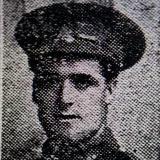
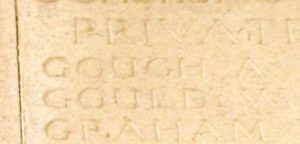
Edward Rees Griffiths, Guardsman, 10442, Grenadier Guards. Edward was the son of James and Margaret Griffiths, of Guilsfield. He was a regular soldier, who had enlisted into the Grenadier Guards several years prior to the war. Edward embarked for France with the 2nd Battalion, Grenadier Guards on 13 August 1914. The battalion was attached to the 4th (Guards) Brigade, 2nd Division and moved to positions guarding the city of Mons, together with the rest of the BEF. Following the German invasion of Belgium, the BEF fought a gallant action at the Battle of Mons, before retreating southwards, fighting at the Affair of Landrecies, the Rearguard Actions of Villers-Cotterets, and at the Battle of the Marne where the German offensive was stopped. The Germans then withdrew north towards the Chemin-des-Dames and the BEF advanced, fighting at the Battle of the Aisne, where the German drive on Paris was halted. The 2nd Division was then moved to Flanders with the BEF and took part in the heroic First Battle of Ypres, where the German advance through Flanders towards the Channel coast was stopped. The 2nd Division remained in Flanders throughout the first winter of the war, holding a section of the line around Cuinchy, with its infantry battalions rotating between duty in the front line, in support and in reserve. Edward was wounded here during March 1915 and was evacuated back to England. He died of his wounds in hospital in Bristol on 9 April 1915. The 40-year-old was buried in Arnos Vale Cemetery, Bristol.
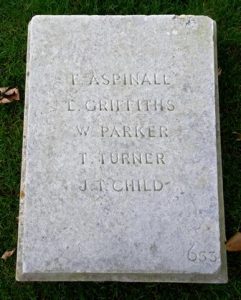
George Griffiths, Private, 89535, Royal Welsh Fusiliers. George was the son of Richard Griffiths and Susannah Griffiths (nee Jones), of Pentrebedd, Guilsfield. His mother died when he was just two years old and George was fostered by Mr Herbert Pryce Evans, of Pantglas, Meifod. At sometime late in the war, George enlisted into the army and was posted to a training battalion of the Royal Welsh Fusiliers. He did not serve overseas but remained in Britain during his short time in uniform. George came home on furlough on December 1919 and is recorded of having died of gunshot wounds at Guilsfield on 24 December 1919. The 18-year-old was buried in Guilsfield Cemetery. George is not commemorated on the Guilsfield war memorial.
John Higgins, Private, 28309, Essex Regiment. John was the son of Robert Higgins and Margaret Higgins, of Stone Cottage, Guilsfield. He worked as a domestic gardener prior to enlisting into the Essex Regiment at Norfolk soon after the outbreak of war. He was drafted to France in the summer of 1916, joining the 13th Battalion, Essex Regiment, which was on the Somme attached to 6 Brigade, 2nd Division. The Division saw heavy fighting during the Battle of Delville Wood in August 1916 and then saw further fighting during the Battle of the Ancre, and the ensuing Operations on the Ancre. In March 1917 the Division followed the German Retreat to the Hindenburg Line, and in April moved north to the Arras sector, taking up positions near Roclincourt in the Oppy Sector. On 18 April the 13th Essex relieved the 17th Royall Fusiliers in the front line to begin its first tour in the Arras trenches and suffered a torrid few days before being relieved on 23 April, moving into reserve at Roclincourt. On the night of 27 April, the battalion moved back into the line, taking over assembly trenches in the Oppy Sector, in readiness for an assault on the following morning. At dawn the following morning, the 2nd Division launched an assault in conjunction with the 1st Canadian Division and the 63rd (Royal Naval) Division upon the Hindenburg Line. John was killed in action during the assault that day, to the south of the village of Oppy. The 23-year-old has no known grave and is commemorated on the Arras Memorial, France.
Richard Herbert Higgins, Chief Engineer, Mercantile Marine. Richard was the son of John and Mary Elizabeth Higgins, of Lower House, Guilsfield. He went to sea as a young man, to train as a Marine Engineer, and later lived at Bryn-Morwel, Somerset Road, Barry, where he married Sarah Margaret Griffiths in 1912. Richard served as Chief Engineer aboard the Elders and Fyffes owned refrigerated cargo steamer, SS Zent. At the beginning of April 1916, Zent set off from Garston to Colombia. During the morning of 5 April 1916, she was steaming off the southern coast of Ireland when she was torpedoed without warning by the German submarine U-66 and sank quickly with the loss of 49 lives. The ship sank so quickly that her two lifeboats were taken down with her, but one popped up, upside down, allowing ten survivors to cling onto it, before being rescued. Richard was among the men drowned when Zent sank that day. The 36-year-old has no known grave and is commemorated on the Tower Hill Memorial, London. Richard is not commemorated on the Guilsfield war memorial, but on the Pool Quay and Arddleen memorial.

John Ingram, Private, 355478, Royal Welsh Fusiliers. John was the son of John Ingram, and Mary Jane Ingram (nee Morris), of Guilsfield. He worked as a farm servant at Burgedin, Llanymynech prior to enlisting into the Montgomeryshire Yeomanry at Welshpool on 8 September 1914. He was discharged as medically unfit just three months later but, undeterred, re-enlisted and was posted to Egypt early in 1917, joining the newly formed 25th Battalion, Royal Welsh Fusiliers. The battalion had been formed 0n 4 March 1917 by the merger of the Welsh Horse Yeomanry and the Montgomeryshire Yeomanry to form the 25th (Montgomery & Welsh Horse Yeomanry) Battalion, Royal Welsh Fusiliers, as part of the newly formed 231 Brigade, 74th (Yeomanry) Division. The Division assembled in Egypt as part of the EEF, before crossing the Suez Canal into the Sinai, and saw its first major action during the Second Battle of Gaza. The battle was a failure, and the EEF was re-organised under a new commander, Sir Edmund Allenby, before launching the Third Battle of Gaza on the night of 31 October 1917. This assault was launched along a winder front, running from Gaza to Beersheba, and this time the EEF prevailed, opening the door to Jerusalem. John had been killed in action during the assault that day, 31 October 1917. The 22-year-old has no known grave and is commemorated on the Jerusalem Memorial, Israel. John is not commemorated on the Guilsfield war memorial.
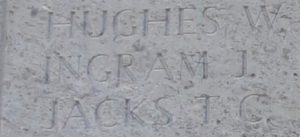
Charles Jones, Private, 12099, King’s Shropshire Light Infantry. Charles was the son of William and Mary Ann Jones, of Lundy Cottage, Meifod. He enlisted into the 6th Battalion, King’s Shropshire Light Infantry at Shrewsbury soon after the outbreak of war. The battalion had formed at Shrewsbury in September 1914, before joining 60 Brigade, 20th (Light) Division at Aldershot. In April 1915 the Division moved to Larkhill, Salisbury Plain and on 22 July 1915 landed at Boulogne. The Division then moved to the Fleurbaix Sector, for trench initiation alongside the 8th Division. When the Battle of Loos was launched on 25 September 1915 the Division fought a diversionary attack towards Fromelles and the 5th KSLI alone lost 63 men killed or wounded. In January 1916 the Division was relieved from the Fleurbaix sector and moved north into the Ypres Salient, taking over positions on the Canal Bank by 11 February. At 02.00 on the following morning, 12 February 1916, the 6th KSLI was in the front line when a German raiding party hit the neighbouring battalion, and the entire line was subjected to a fearsome artillery barrage. Charles was among seventy casualties suffered by the battalion that morning when he was killed by a shell burst. The 27-year-old is buried in Artillery Wood Cemetery, Belgium.
Charles Jones, Stoker 2nd Class, K/46782, Royal Navy. Charles was born on 6 June 1887, the son of Elijah and Martha Jones, of Alyn, Guilsfield. By 1911 he was lodging with William and Hannah Tucker, at Cwmpark, Rhondda, where he worked as a coal hewer. He returned home to Guilsfield prior to the war and in the summer of 1914 married Elizabeth Annie Jones, of Llanarch, Guilsfield. Charles enlisted into the Royal Navy on 26 October 1917 and was posted to HMS Vivid II, the Shore Establishment at Devonport, for training as a Stoker. On 19 February 1918 Charles was posted aboard the sloop, HMS Anchusa. On 16 July 1918, Anchusa was on patrol off the north coast of Ireland when she was torpedoed and sunk by the German submarine U-54m going down with the loss of 78 lives. Charles was 31 years old when he died that day and is commemorated on the Plymouth Naval Memorial, Devon.
Edwin Jones, Rifleman, 304009, London Regiment. Edwin was the son of Edwin and Mary Jones, of The Belan, Guilsfield. He worked as a Sexton prior to the war. Edwin enlisted into the 8th Battalion, London Regiment in London soon after the outbreak of war. He was drafted to France early in 1916 and was posted to the 5th Battalion, London Regiment (London Rifle Brigade), which was attached to 169 Brigade, 56th (London) Division. The Division moved to the Somme sector in February 1916, taking up positions near Hébuterne, on the northern Somme sector. The Division took part in the diversionary attack on Gommecourt, in conjunction with the 46th and 48th Divisions, on the opening day of the Battle of the Somme, on 1 July 1916. The Division then moved to Foncquevillers to refit before moving to Hannescamps and did not return into the line until 5 September when it moved forwards past Fricourt and Mametz to Leuze Wood in front of Ginchy. On the following morning, 6 September 1916, the Division assaulted Ginchy, which sat on a prominent position overlooking the German held village of Combles. Edwin’s battalion launched its assault on Ginchy at 04.45 but made not real gains and suffering terrible casualties was forced to withdraw. Edwin was killed in action during the terrible fighting that day. The 39-year-old is buried in Combles Communal Cemetery Extension, France. His brother, James, was killed in Palestine the following year.
George Robert Jones, Private, 203068, Royal Welsh Fusiliers. George was the son of George and Catherine Jones, of Geuffordd, Guilsfield. George worked as a farm labourer prior to enlisting into the Montgomeryshire Yeomanry at Welshpool on 7 September 1914, and was posted to Park Hall Camp, Oswestry for training. He embarked for France at Southampton on 17 December 1916 and disembarked at Le Havre, joining the 5th Infantry Base Depot. On 5 January 1917 George was posted to the 1/4th Battalion, Royal Welsh Fusiliers, which was the Pioneer Battalion to the 47th (2nd London) Division. In October 1916 the Division had moved north to Belgium from the Somme sector, taking over a section of the front line running south from Hill 60 to the Ypres-Comines Canal and remained here until taking part in the Battle of Messines Ridge on 7 June 1917. The men of the 4th RWF worked tirelessly during the battle to repair roads and to extend the Spoil Bank tram line. In September 1917 the 47th Division was relieved and moved south, taking over positions some 2,000 yards north of Arras. The men of the 4th RWF again began work on road repairs, in preparation for the forthcoming Battle of Cambrai, which was launched on 20 November 1917. The battle raged until 6 December, by which time a German counterattack had been quashed and the 47th Division wintered in the area, stationed near Metz. By March 1918 the Division was situated near St. Quentin, and faced the German Spring Offensive here on 21 March 1918, seeing heavy fighting over the coming days as it was forced to withdraw across the old Somme battlefields towards Albert. George was wounded during the terrible fighting during the withdrawal and was evacuated to the 18th General Hospital at Camiers, where he died of his wounds on 8 April 1918. The 20-year-old was buried in Étaples Military Cemetery, France.
James Jones, Corporal, 290855, Royal Welsh Fusiliers. James was the son of Edwin and Mary Jones, of The Belan, Guilsfield. He was educated at Welshpool County School and on leaving became an assistant at the Berriew Road Boys’ School. He then entered Aberystwyth University but was erupted soon afterwards and James enlisted into the 7th Battalion, Royal Welsh Fusiliers at Welshpool on 21 November 1914. The battalion was a Territorial unit, which mobilised for war at Newtown in August 1914, as part of North Wales Brigade, Welsh Division and moved to Conway until the end of the month, before moving to Northampton. In December the Division moved to Cambridge and then in May 1915 to Bedford, where the Division was numbered and the formation became 158 Brigade, 53rd (Welsh) Division. On 19 July 1915 the entire Division sailed from Devonport for Imbros and on 9 August 1915 landed at Suvla Bay. The infantry moved off the beaches across the Salt Lake, under shellfire, into the scrub covered Chocolate Hill, but due to a lack of maps and no knowledge of the terrain, many of the units became disorientated, and the situation became chaotic. The Division was eventually evacuated from Gallipoli in December 1915, moving to Egypt to join the EEF, and helped guard the Suez Canal before taking part in operations to drive the Turks out of the Sinai. The EEF then turned its attention onto driving the Turks out of Palestine, and on 26 March 1917 launched its first offensive against the coastal city of Gaza, which guarded the road to Jerusalem. Initial gains during the day were lost when the assaulting divisions lost touch with each other, and communication broke down when a thick fog cloaked the battlefield. A second attempt to force Gaza was launched on 17 April, which also failed, and the EEF suffered a change in leadership, with Sir Edmund Allenby assuming command, before being re-organised, and a third offensive was launched against a wider front from Beersheba to Gaza on 31 October 1917. This time the Turkish defences were breached, and the road to Jerusalem now lay open and the EEF began to advance north. On 6 November 1917, 158 Brigade launched an attack on the Khuweilfeh Heights. James was shot in the chest during the advance and was evacuated to the 231st Field Ambulance where he died of his wounds on 11 November 1917. The 21-year-old is buried in Beersheba War Cemetery, Israel. His elder brother, Edwin, was killed on the Somme in 1916.
William Jones, Lance Corporal, 26716, King’s Shropshire Light Infantry. William was the son of William Jones and Mary Jane Jones (nee Edwards), of Cefn Pentre, Guilsfield. He worked as a farm labourer prior to enlisting into the Montgomeryshire Yeomanry at Welshpool. William was drafted to France in the late summer of 1916 was posted to the 7th Battalion, King’s Shropshire Light Infantry, which was attached to 8 Brigade, 3rd Division. The Division saw terrible fighting on the Somme during the summer of 1916. By May 1917 the Division was at Arras and fought at the First and Second Battles of the Scarpe, and at the Battle of Arleux and the Third Battle of the Scarpe, where they captured Roeux. The Division then moved north and fought in the Third Battle of Ypres, at the Battle of the Menin Road and the Battle of Polygon Wood, then in November the Division moved south again, where it fought at the Battle of Cambrai. The Division was caught up in the heavy fighting which followed the German Spring Offensives in March and April 1918 and later that year took part in the great advance which ultimately won the war. After the Armistice William was demobilised and returned home. He began work as a farm labourer at the Viggin, Maesmawr, but took ill and died at the Institute, Welshpool on 11 August 1918. The 25-year-old was buried in Guilsfield Cemetery.
Alan Langlands, Second Lieutenant, South Wales Borderers. Alan was born at Longrood, Rugby, Warwickshire on 25 September 1894, the son of Captain John Shakespeare Langlands and Lucy Alice Langlands (nee Beck). His father died the following year, and his mother re-married Major Charles Harold Longfield Beatty, DSO, at Leighton on 31 January 1905, and the family took up residence at Trelydan Hall. Alan’s new stepfather was a brother of Vice Admiral Sir David Beatty, the commander of the Royal Navy’s Battle Cruiser Fleet. With all the military connections in the family, it was no surprise that Alan gained a commission as Second Lieutenant into the 3rd Battalion, South Wales Borderers on 7 October 1914, after completing his education at Stubbington and Wellington College. Alan embarked for France on 5 March 1915, and joined the 1st Battalion, South Wales Borderers, which was in the Festubert sector, attached to 3 Brigade, 1st Division. The battalion was enduring a torrid time, due to the weather, with the trenches being waterlogged, and men were being invalided daily due to health conditions. Alan joined the battalion in reserve at Essars on 11 March 1915. On the previous day the British had launched an offensive at Givenchy and Neuve Chapelle, to divert German attention away from a French offensive to the south at Notre Dame De Lorette. The fighting raged over the coming days, but the 1st SWB remained in reserve, within hearing distance of the fighting. On 14 March the battalion moved to billets at Hingette, where it received orders to be prepared to move at two hours’ notice, but didn’t move until 23 March, when the 1st SWB moved to Lacouture, relieving the Indians of the Jullundur Brigade in the Neuve Chapelle trenches, near Porth Arthur, on the following day. The battalion endured another torrid time in the trenches, with relentless rain and sporadic artillery fire over the coming days causing several casualties. The battalion was relieved on 31 March and moved to dugouts at Windy Corner, Cuinchy. On 7 April the battalion moved to Hingette, taking over billets in the village, and remained there for several days, carrying out a system of training. On 15 April the battalion moved into the line at Richebourg-L’avoue and enjoyed a relatively peaceful spell before being relieved on 25 April, marching back to billets in Hingette. On 8 May the battalion left Hingette, taking over support trenches at Rue Du Bois, to support an assault by the 2nd Welsh on the following day. At 05.40 on 9 May 1915, the 2nd Welsh took part in an offensive known as the Battle of Aubers Ridge but became held up by a flooded ditch and suffered heavy casualties from machine-gun fire. The 1st SWB was ordered forward to take over the original front-line trenches but began suffering heavy casualties as the men advanced. Alan had survived this move, but at 17.00 the battalion launched an assault against the German lines, and he was shot dead as he came out of the trench. The remains of the 19-year-old were recovered from the battlefield, and he was buried in St. Vaast Post Military Cemetery, Richebourg L’Avoue, France. His stepfather, Major Charles Harold Longfield Beatty, DSO, died of wounds in 1917, whilst an uncle, Second Lieutenant Noel Pryce James Turner, of the 2nd Welsh, had sadly been killed in the same action as Alan.
Arthur Trevor Lewis, Private, 38012, Gloucestershire Regiment. Arthur was born at Guilsfield in 1890, the son of Reverend James Sculthorpe Lewis and Emily Martha Lewis (nee Bate). His father was the Rector of Guilsfield for several years but by 1901 had taken up the position of Rector of Ruabon. Arthur lived at Northwick Road, Evesham prior to the war and enlisted at Evesham into the 12th (Bristol) Battalion, Gloucestershire Regiment. The battalion had landed in France on 21 November 1915 attached to 95 Brigade, 32nd Division, but the following month transferred with the Brigade to the 5th Division. Arthur probably joined the battalion at Ypres in the late summer of 1917. The 5th Division was transferred to the Italian Front in November 1917, but as a result of the heavy losses suffered by the Allies during the German Spring offensive of 21 March 1918, the Division was recalled to France in April and took part in the Defence of Nieppe Forest upon its arrival. By now Arthur had been discharged from the army and returned home. He died at Sutton Coldfield on 5 April 1918. The remains of the 27-year-old were conveyed back to Ruabon, and he was buried in Ruabon Cemetery on 9 April.
David Edward Lloyd, Private, 12226, Royal Welsh Fusiliers. David, known as Edward, was the son of Edward and Ann Jane Lloyd, of Genffordd Cottage, Guilsfield. He worked as a waggoner at Llanymynech prior to the war. David originally enlisted at Welshpool into the Montgomeryshire Yeomanry and was posted to Park Hall Camp, Oswestry for training. He was drafted to France early in 1916, joining the 1/4th Battalion, Royal Welsh Fusiliers, which was the Pioneer Battalion to the 47th (2nd London) Division. In October 1916 the Division had moved north to Belgium from the Somme sector, taking over a section of the front line running south from Hill 60 to the Ypres-Comines Canal. The 4th RWF then began work on road repairs and improvements as well as laying railways and trench tramways over the coming months. The battalion was at work on a broad-gauge railway near The Bluff on 13 January 1917 when David was killed in action, the sole casualty in the battalion that day. The 23-year-old is buried in Bedford House Cemetery, Belgium. His brother, John Edward Lloyd, died in France just after the Armistice.
John Edward Lloyd, Private, 48391, Manchester Regiment. John was the son of Edward and Ann Jane Lloyd, of Genffordd Cottage Guilsfield. He married Lilian Ada Sankey, the great niece of Ann Sankey, of High Gate, Meifod at Manchester in 1904. John worked as a railway porter in Manchester and the couple set up home at 2, Craven Street, Hulme, Manchester, where Lilian bore two daughters and two sons over the coming years. John enlisted at Manchester into the Manchester Regiment, and after being drafted to France in the autumn of 1917 was posted to the 16th Battalion, Manchester Regiment, which was attached to 90 Brigade, 30th Division. The Division was fighting in the Third Battle of Ypres when John joined the ranks of the 16th Manchester’s. The Division then transferred south and by the beginning of 1918 was stationed near St. Quentin, where it was hit hard following the launching of the German Spring offensive on 21 March 1918. After suffering severe casualties during its withdrawal to the Somme crossings, the battered Division was moved north to the Lys to rest and rebuild but was caught up in the second phase of the German offensive, which was launched along the Lys Valley on 9 April 1918. Following heavy losses during the German offensives, the battalion was reduced to a training cadre on 30 May 1918, then on 18 June was posted to 42 Brigade, 14th (Light) Division, which had been rebuilding at Boulogne. The Division then moved to Flanders to take part in the great offensive in Flanders and by the time of the Armistice was at Petit Audenarde, on the Belgian frontier. John took ill after the Armistice, contracting influenza, and died of influenza and bronchial pneumonia on 12 December 1918. The 35-year-old was buried in Tournai Communal Cemetery Allied Extension, Belgium. One of his two sons, Eric Lloyd, was killed with the Royal Navy in 1944, while a brother, David Edward Lloyd, was killed at Ypres in 1917.
William Lloyd, Private, 291605, Royal Welsh Fusiliers. William was born in Guilsfield in 1888, the son of John Lloyd and Margaret Lloyd (nee Caswell). His father died in 1898 and in 1901 Margaret remarried Arthur William Lewis, of London House, Welshpool, who raised William and his siblings as his own. William enlisted into the 7th Battalion, Royal Welsh Fusiliers at Welshpool soon after the outbreak of war, and was posted to the 3/7th Battalion, Royal Welsh Fusiliers at Park Hall Camp, Oswestry for training. William was drafted to Egypt early in 1916, joining the 1/7th Battalion, Royal Welsh Fusiliers, which was attached to 158 Brigade, 53rd (Welsh) Division. The Division had been evacuated from Gallipoli in December 1915, moving to Egypt to join the EEF, and helped guard the Suez Canal before taking part in operations to drive the Turks out of the Sinai. The EEF then turned its attention onto driving the Turks out of Palestine, and on 26 March 1917 launched its first offensive against the coastal city of Gaza, which guarded the road to Jerusalem. Initial gains during the day were lost when the assaulting divisions lost touch with each other, and communication broke down when a thick fog cloaked the battlefield. William was killed in action during the assault that day. The 29-year-old has no known grave and is commemorated on the Jerusalem Memorial, Israel. William is not commemorated on the Guilsfield war memorial, but at Welshpool.
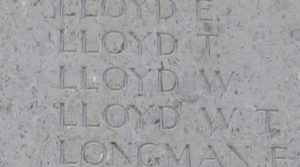
Richard Edward Morgan, Private, 56995, Welsh Regiment. Richard was the son of William Arthur Morgan and Annie Elizabeth Morgan, of Guilsfield. He resided at Pentrebyarth, Guilsfield prior to the war. Richard enlisted into the Montgomeryshire Yeomanry at Welshpool on 21 June 1915 and was posted to the 3/1st Battalion, Montgomeryshire Yeomanry at Park Hall Camp, Oswestry for training. Richard embarked for France at Southampton on 8 August 1916 and joined the 5th Infantry Base Depot at Rouen. On 16 August he was posted to the 10th Battalion, Welsh Regiment. The battalion was attached to 114 Brigade, 38th (Welsh) Division and had just been relieved from the Somme, following its epic assault on Mametz Wood the previous month. It then took over a section of the front at Hébuterne before moving to the Ypres Salient, taking over the Canal Bank sector at Boesinghe. The infantry battalions of the Division then began carrying out the normal pattern of rotation in the trenches, four days in the front, four in support and four in reserve, whilst also working on trench improvement, digging new trenches, and also carrying out regular patrols and trench raids. On 31 July 1917 the Division launched its famous assault on the Pilckem Ridge, capturing Iron Cross and reaching its objective of the Steenbeek, then played a supporting role in the Battle of Langemarck. The Division was transferred to the Sailly-sur-la-Lys sector in September and remained in the area over the winter. In February 1918 the 10th Welsh was disbanded, and Richard was posted to the 19th Battalion, Welsh Regiment, which was the Pioneer Battalion to the 38th (Welsh) Division. The Division moved to positions north of Albert, at Bouzincourt Ridge, at the end of March 1918, relieving the battered 2nd and 47th Divisions. It held this sector, again carrying out minor operations and trench raids, over the coming months. Richard was then transferred again, to the 14th Battalion, Welsh Regiment, in the same 114 Brigade, 38th (Welsh) Division. The Division took part in the great offensive of 21 August 1918, crossing the flooded River Ancre and began its advance towards the Hindenburg Line over the coming days. Richard was wounded during the initial stages of the offensive and was evacuated to hospital in Rouen, where he died of his wounds on 7 September 1918. The 22-year-old is buried in St. Sever Cemetery Extension, Rouen, France.
William Morgan, Private, 11741, South Wales Borderers. William was born in Guilsfield in 1891, the son of William Morgan. He was raised by John and Marie Jones, at 3, park Road, Guilsfield prior to enlisting into the South Wales Borderers as a young man. William embarked for France on 20 September 1914, joining the 1st Battalion, South Wales Borderers, which was on the Aisne attached to 3 Brigade, 1st Division, having taken part in the epic retreat from Mons to the Marne and joined the battalion at Vendresse. On 17 October the 1st SWB entrained for Étaples, before moving to Flanders with the BEF. The 1st Division originally took up positions north-east of the city, at Langemarck and entrenched there, awaiting the advancing German army which was attempting to reach the Channel coast. The Germans launched their first assault on the Ypres Salient on 19 October, with almost suicidal charges by young soldiers against the experienced riflemen of the BEF at Langemarck, and the 1st SWB moved into the line there on 21 October. An officer of the battalion who witnessed the carnage wrote that day: ‘The Germans came on in great masses, silly idiots…’ The 1st Division then moved to positions east of the city of Ypres, along the Menin Road at Gheluvelt and on 31 October 1914 came under heavy attack again. William was killed in action during the fighting that day. The 23-year-old has no known grave and is commemorated on the Ypres (Menin Gate) Memorial, Belgium. William is not commemorated on the Guilsfield war memorial.
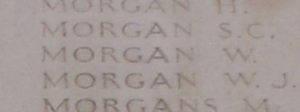
Edward Morris, Private, 203093, Royal Welsh Fusiliers. Edward was the son of John and Sarah Morris, of Stone House, Guilsfield. He married Catherine Lewis, of Rednal, at Penrhos on 23 July 1908 and the couple later resided at Middlehouse, Guilsfield. Edward worked as a farm labourer prior to enlisting at Welshpool into the Montgomeryshire Yeomanry on 17 August 1916 and was posted to park hall Camp, Oswestry for training. He had served with the regiment for three years prior to the war and had attended four annual TA summer camps, so had some prior military experience. Edward embarked for France at Southampton on 17 December 1916 and joined the 5th Infantry Base Depot at Rouen. On 5 January 1917 he was posted to the 1/4th Battalion, Royal Welsh Fusiliers, which was at Ypres and was the Pioneer Battalion to the 47th (2nd London) Division. In October 1916 the Division had moved north to Belgium from the Somme sector, taking over a section of the front line running south from Hill 60 to the Ypres-Comines Canal and remained here until taking part in the Battle of Messines Ridge on 7 June 1917. The men of the 4th RWF worked tirelessly during the battle to repair roads and to extend the Spoil Bank tram line. The Division took part in the Battle of Messines Ridge on 7 June 1917 and the 4th RWF worked hard once more, repairing roads and extending a trench tramway over the coming days. Edward was wounded just after the initial attack and was evacuated to the 2nd Canadian Casualty Clearing Station at Lijssenthoek, suffering from multiple gunshot wounds. He died of his wounds there on 15 June 1917. The 30-year-old is buried in Lijssenthoek Military Cemetery, Belgium.
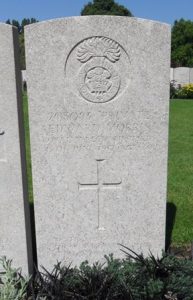
Matthew Henry Morris, Private, 55475, Royal Welsh Fusiliers. Matthew was the son of Thomas Marple Morris and Elizabeth Morris, of Cyfronydd Villa, Llanfair Caereinion. He worked as a waggoner at Lower Trefnant, Maesmawr, Guilsfield prior to marrying Alice Ellis of Llyndu, Guilsfield on 4 December 1912. Matthew enlisted into the Montgomeryshire Yeomanry at Welshpool soon after the outbreak of war and was posted to the 3/1st Battalion at Park Hall Camp, Oswestry for training. He was drafted to France in the winter of 1916-17, joining the 17th Battalion, Royal Welsh Fusiliers. The battalion was attached to 115 Brigade, 38th (Welsh) Division, which had moved to Ypres in September 1916 following its epic assault on Mametz Wood in July. The Division then took over the Canal Bank sector at Boesinghe. The infantry battalions of the Division then began carrying out the normal pattern of rotation in the trenches, four days in the front, four in support and four in reserve, whilst also working on trench improvement, digging new trenches, and also carrying out regular patrols and trench raids. On 31 July 1917 the Division launched its famous assault on the Pilckem Ridge, capturing Iron Cross and reaching its objective of the Steenbeek, then played a supporting role in the Battle of Langemarck. The Division was transferred to the Sailly-sur-la-Lys sector in September and remained in the area over the winter before being moved to positions north of Albert, at Bouzincourt Ridge, at the end of March 1918, relieving the battered 2nd and 47th Divisions. It held this sector, again carrying out minor operations and trench raids, over the coming months, before taking part in the great offensive of 21 August 1918, and began its advance towards the Hindenburg Line. The 17th RWF remained in reserve for the initial assault then at dawn on 23 August 1917 crossed the Ancre at Albert and relieved the 13th RWF from the front line. Matthew was killed in action just after the relief that morning. The 24-year-old has no known grave and is commemorated on the Vis-en-Artois Memorial, Haucourt, France.
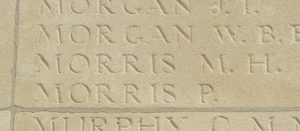
Richard Devereux Hugh Mytton, Second Lieutenant, London Regiment. Richard was born at 50, Lansdowne Road, Notting Hill, London, on 7 February 1882, the son of Robert Furrier Mytton and Annie Elizabeth Mytton (nee Cracknall), of Guilsfield and Kensington. His parents divorced when he was three years old and Richard was raised by his mother, who died in 1911. He worked as a Clerk in the Stock Exchange in London prior to the war, when he enlisted into the Inns of Court Officer Training Corps. Richard was then commissioned as Second Lieutenant into the 1st Battalion, London Regiment (Royal Fusiliers) and embarked for France on 22 August 1916, joining the battalion on the Somme, where it was attached to 167 Brigade, 56th (London) Division. The Division had suffered terrible casualties during its diversionary attack at Gommecourt on 1 July 1916 and was forced to rebuild before returning to the line and taking part in the Battle of Ginchy. The Division then took part in the Battle of Flers, which saw the first use of tanks on the Western Front. Richard joined the 1st London’s at Billon Farm on 20 September, after it had been relieved from the line to rest and two days later had his first experience in the trenches when the battalion moved back into the line again near Leuze Wood, taking over positions at Bully and Beef trenches, northwest of Bouleaux Wood. The Division then took part in the Battle of Morval, where it captured the village of Combles. By 1 October 1916 the 1st London’s were in the line again at Lesboeufs and took part in another advance by the Division against Le Transloy. Richard, in command of B Company, led his men forward into Rainy Trench, but was mortally wounded during the advance, dying that same day. The 34-year-old has no known grave and is commemorated on the Thiepval Memorial, France.
John Owen, Corporal, 241269, Cheshire Regiment. John was the son of John and Mary Elizabeth Owen, of Hillside, Pant. His mother was from Guilsfield, but prior to the war John lived with his wife, Lily Owen, in Altrincham, Cheshire. John enlisted at Cheadle into the Cheshire Regiment, and was posted to France early in 1917, joining the 1/5th Battalion, Cheshire Regiment. The battalion was by then the Pioneer Battalion to the 56th (London) Division, and was in the Arras sector when John arrived, and all of the men were employed on road maintenance. The Division then fought at the Battle of Arras, before being transferred north to the Ypres Salient, taking part in the Battle of Langemarck. The Division was then transferred south again, and took part in the Battle of Cambrai, remaining in the area for the winter. The Division was in the Arras sector when the German Spring Offensive was launched on 21 March 1918. The 5th Cheshire’s were at work at Ste. Catherine when the Germans began their preliminary artillery bombardment and took up defensive positions with the Division on the Green Line until 27 March, when it relieved the Canadians at Arleux. The main fighting was raging to the south, as the first phase of the German attack had been on the section of front running south from Croisilles to La Fère, so the Division escaped the worst of the fighting until 28 March, when it was subjected to a full-frontal attack. Heavy fighting ensued over the coming days, but by 9 April German attention had moved further north, as they launched the second phase of their offensive along the Lys Valley. The Arras sector quietened down, and the 5th Cheshire’s began work on trench consolidation work over the coming weeks. John was wounded whilst the battalion was working on the Blangy System at the end of May, and was evacuated to Hospital in Aubigny, where he died of his wounds on 3 June 1918. The 25-year-old is buried in Aubigny Communal Cemetery Extension, France.
Evan Phillips, Private, 60161, Welsh Regiment. Evan was the son of David and Mary Phillips, of Cefndre, Guilsfield. He married Elizabeth Ann Evans on 23 December 1911 and the couple lived at Viggin, Maesmawr. Evan worked as a timber haulier prior to enlisting at Welshpool into the 3rd Battalion, Welsh Regiment on 6 December 1915 and was initially placed on the Army Reserve. He was mobilised on 6 June 1917, travelling to Wrexham to attest before being posted to the 3rd Battalion, Welsh Regiment, which by then was at Redcar. Evan embarked for France at Southampton on 6 November 1917, joining the 5th Infantry Base Depot at Rouen. On 5 December 1917 he joined the 9th Battalion, Welsh Regiment, which was in the Cambrai sector, in the Flesquières Salient facing the Hindenburg Line, attached to 58 Brigade, 19th (Western) Division. On 21 March 1918 the Germans launched the first of three offensives on to the section of the front running from Flesquières to St. Quentin, and the 19th Division was thrown into desperate fighting as it was pushed back over the coming days. The battered Division was then moved to the Messines sector to rest, but on 11 April became caught up in the second phase of the German offensive, which had been launched along the Lys Valley on 9 April, and again became caught up in desperate fighting, before the survivors took up quieter positions near Ypres. Evan was killed whilst the 9th Welsh was holding the Vlamertinghe to Hallebast Line near Ypres on 29 April 1918. The 28-year-old has no known grave and is commemorated on the Tyne Cot Memorial, Belgium.
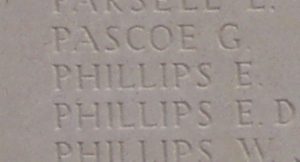
John Thomas, Private, 1185, Monmouthshire Regiment. John was born at Guilsfield in 1887. He moved to South Wales to work as a miner prior to the war and married Gwenllian John, of 5, Howell Terrace, Dukestown, Tredegar in 1914. The couple had a son, Richard John Thomas, born in 1915. John enlisted at Sirhowey into the 3rd Battalion, Monmouthshire Regiment. The battalion was a Territorial Army unit and mobilised for war at Abergavenny on 4 August 1914 as part of the Welsh Border Brigade, Welsh Division, before moving to its war station at Pembroke Dock. The Division then moved to Oswestry before moving again to Northampton. In February 1915 the 3rd Monmouth’s left the Welsh Division and landed in France on 14 February 1915, joining 83 Brigade, 28th Division at Steenvoorde before moving into the Ypres Salient with the Division. The infantry battalions of the Division then began the usual routines of rotating for duty in the trenches, normally four days in the front line, four in support and four in reserve, under instruction alongside more seasoned battalions for the first weeks. On 12 March the 3rd Monmouth’s moved into the front line at Wulverghem to begin its first proper tour. Five days later the battalion was relieved, moving to huts near Dranoutre and then moved back into the front line for another tour on 23 March. This routine continued over the coming weeks, but on 17 April the 3rd Monmouth’s moved back into the line for what would turn out to be a prolonged and terrible spell. The Second Battle of Ypres opened on 22 April 1915, following the wars first gas attack when the Germans released 171 tons of gas upon the trenches held by a French Colonial Division at Gravenstafel. The line was smashed as the French ran in fear and the situation was only saved when the Canadian Corps was moved forwards to plug the gap. Fighting raged over the coming days, then the Germans turned their attention to positions at St. Julien. All the while the 3rd Monmouth’s remained in the line near Polygon Wood, fully aware of the situation to their north, before being forced with withdraw from the Polygon Wood sector evacuated on 3 May, when the Battalion retired onto the G.H.Q. line at Potijze. The front line was now being subjected to almost constant artillery fire and after suffering terrible casualties, the 3rd Monmouth’s were relieved and withdrew to Vlamertinghe, leaving B Company behind. All of the Divisions battalions had by now been decimated, so on 10 May a composite battalion was formed from the survivors of 83 Brigade which proceeded back to the G.H.Q. line Potijze. On the following day, 11 May 1918 the composite battalion came under attack and vicious fighting ensued. John was killed in action during this fighting that day. The 28-year-old has no known grave and is commemorated on the Ypres (Menin Gate) Memorial, Belgium. John is not commemorated on the Guilsfield war memorial.
Gruffydd Vaughan Trevor, Lieutenant, Royal Engineers. Gruffydd was the son of Major Tudor Gruffydd Trevor, of Trawscoed, Guilsfield and of Henrietta Eliza Trevor (nee Dunkley), of Pretoria. Gruffydd was born and raised in KwaZulu-Natal in South Africa, where his father was Inspector of Mines for the SA Government and later an author. Soon after the outbreak of war, Gruffydd enlisted into the South African Defence Force, but embarked at Durban for London, where he disembarked on 8 October 1915 and on 26 October was commissioned as Second Lieutenant into the Royal Engineers. A Mining Engineer himself by profession, Gruffydd was posted to the 255th Tunnelling Company, Royal Engineers. The Company was formed in January 1916 among a number of other such units, in order to dig underground saps, mines and dugouts and moved into Red Lamp-Neuve-Chapelle sector. It then moved to the Laventie-Fauquissart sector in northern France and remained there until being relieved by the 3rd Australian Tunnelling Company in May 1916 and moved to the Givenchy area, where it remained for much of 1916. The Company then moved to the Vimy Sector and began the construction of subways to the Vimy front in early 1917, in preparation for the forthcoming assault by the Canadian Corps on Vimy Ridge. The Company then moved back to the Givenchy Sector, where it remained until the Germans launched their offensive on the Lys on 9 April 1918 and was forced to move from its camp at Boescheppe to begin work on wiring and digging trenches. The 255th TC then moved to the Ypres Salient, where it remained for the rest of the war, spending the final months searching for booby traps as the Germans were pushed back. Gruffydd had almost survived the war, but sadly took ill and died of pneumonia in hospital at Boulogne on 5 November 1918. The 28-year-old was buried in Terlincthun British Cemetery, Wimille, France. His cousin, Herbert Edward Trevor, also fell during the war.
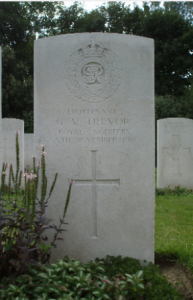
Herbert Edward Trevor, Lieutenant Colonel, Northamptonshire Regiment. Herbert was born on 26 May 1884, the son of Surgeon General Sir Francis Wollaston Trevor, KCSI, CB and of Lady Mary Helen Trevor (nee Mytton), of Trawscoed, Guilsfield. He was educated at Rugby School before passing through the Royal Military Academy at Sandhurst. Herbert was commissioned from Sandhurst as Second Lieutenant into the Northamptonshire Regiment in 1903. He passed through the Staff College in 1914 and was appointed General Staff Officer with the BEF. Herbert was then appointed to Brigade-Major of 37 Brigade, 12th Division, taking part in the Second Battle of Ypres and in the Battle of Loos. He was wounded near the Hohenzollern Redoubt in October 1915, then in November 1916 was given command of the 9th Battalion, Essex Regiment. The battalion was attached to 35 Brigade, 12th Division and had seen heavy fighting on the Somme just prior to Herbert taking over command. The Division had by then been relieved and moved to the Arras Sector. Herbert led the battalion throughout the Battle of Arras the following year and also in a gallant assault against the German third line in the Battle of Vimy Ridge. The 9th Essex was awaiting relief from the front line on 11 April 1917 when Herbert was killed by a German shell which came down and scored a direct hit as he was in Battalion HQ in a cellar beneath a ruined building at Feuchy Chapel. The remains of the 32-year-old were recovered from the ruined cellar, and he was buried in Faubourg D’Amiens Cemetery, Arras, France. Herbert had been Mentioned in Despatches three times during the war. His cousin, Gruffydd Vaughan Trevor, also fell during the war.
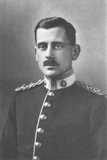
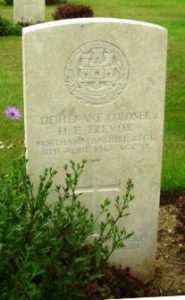
Edwin Williams, Corporal, 7296, King’s Shropshire Light Infantry. Edwin was born at Guilsfield in 1879, the son of Edmund and Louisa Williams, of 12, Stanley Street, Guilsfield. He left home as a young man to enlist into the 24th Regiment of Foot, South Wales Borderers, and served with the 2nd Battalion, South Wales Borderers during the Anglo Boer War of 1899-1902. Edwin left the army on his return home from South Africa, joining the Army Reserve, and married Emily Matthews, of Buttington, on 6 February 1904. The couple then moved to Forge House, Hereford Street, Meole Brace, Shrewsbury, where Edwin ran his own blacksmith’s forge. Edwin was mobilised at the outbreak of the Great War and re-enlisted into the King’s Shropshire Light Infantry at Shrewsbury. Edwin was then posted to D Company of the 5th Battalion, King’s Shropshire Light Infantry. The battalion had formed at Shrewsbury in August 1914 before joining 42 Brigade, 14th (Light) Division at Aldershot. On 20 May 1915 Edwin landed in France with the battalion, which moved to the Eecke area before the entire Division assembled in the Ypres Salient, taking over a section of the front line near Zillebeke, some two miles southwest of Ypres. The Division was to see its first action during the Action of Hooge on 2 June 1915, where it became the first unit to be attacked by the German use of flamethrowers. On 24 September the 5th KSLI moved out of their rest camp at Poperinghe into the front-line trenches east of Ypres and on the following day, 25 September 1915, took part in a diversionary assault by the 14th Division, known as the Second attack on Bellewaarde. The assault was an attempt to divert German attention away from the main battle area at Loos but resulted in terrible casualties for the 14th Division with the 5th KSLI along suffering over 420 casualties. Edwin was killed in action during the attack that day. The 36-year-old has no known grave and is commemorated on the Ypres (Menin Gate) Memorial, Belgium. Edwin is not commemorated on the Guilsfield war memorial.
World War Two, 1939-1945
Jack Ernest Astley, Fusilier, 4195064, Royal Welch Fusiliers. Jack was the son of Edmund Astley and Frances Alice Astley (nee Blower), of Golfa. Both his parents had been married before and been widowed. His mother’s first husband, William Pryce Astley, no relation to her second husband, had been killed in WW1. Jack enlisted into the 10th Battalion, Royal Welch Fusiliers soon after the outbreak of war. The battalion was a second line TA unit, attached to the 38th (Welsh) Division, and was used for training troops ready to send them to front line units, as well as playing an important role on home defence, but in 1942 was converted into a Parachute Regiment battalion. Jack died on home service on 8 February 1940, aged 20. His remains were brought home for burial in St. Cynyw’s Churchyard, Llangyniew.
Thomas Charles Evans, Private, 14541574, North Staffordshire Regiment. Thomas was born on 7 March 1924, the son of Charles Lambert Evans and Mary Winifred Evans (nee Wilson), of Guilsfield. He served with the 2nd Battalion, North Staffordshire Regiment, which was attached to the 2nd Infantry Brigade. They were present at the Fall of France in 1940 as part of the BEF and were evacuated at the end of May 1940. They then moved to North Africa, where they fought throughout the Campaign in the Western Desert and took part in the landings at Anzio in 1944. Thomas was killed in action at Anzio on 31 May 1944, aged 20. He is buried in Beach Head War Cemetery, Anzio, Italy.
William David Herbert Harris, Sapper, 14667781, Royal Engineers. William was the son of William Herbert Harris and Margaret Annie Harris (nee Price), of Stone Cottage, Guilsfield. He enlisted into the Royal Engineers and was selected for parachute training, before being posted to the elite 9th Airborne Squadron, Royal Engineers, which was attached to the 1st Airlanding Brigade, 1st Airborne Division. William had survived the actions which the 1st Airborne Division took part in from D-Day onwards, and after the Armistice was sent to Norway with the 9th Airborne Squadron, to act as peacekeepers, with the Division being tasked with the division was tasked with supervising the surrender of the German forces in Norway, as well as preventing the sabotage of vital military and civilian facilities. William died in Oslo on 30 May 1945, although the circumstances of his death are not known. The 21-year-old is buried in Oslo Western Civil Cemetery, Norway.
Eldon Wyn Hughes, Corporal, 1054384, Royal Air Force Volunteer Reserve. Eldon was born on 11 February 1917, the son of Maurice Hughes and Jane Ellen Hughes (nee Owen), of Guilsfield. He married Evelyn Lockyer, of Guilsfield, in 1940. Eldon enlisted into the Royal Air Force Volunteer Reserve and was posted to the Central Link Training School. Eldon took ill whilst stationed there and was admitted to Shenley Hospital at St. Albans. He died there of fluid on the brain on 17 January 1944. The remains of the 28-year-old were brought home for burial in Guilsfield Cemetery.
Joseph Hugh Jepson. Joseph was born on 27 February 1911, the son of John William Jepson and Sarah Ann Jepson (nee Davies), of Little Tybrith, Guilsfield. He was a heavy constructional engineer and married Esther Sarah Ann Astley, the daughter of William Pryce Astley, who was killed in France during the Great War, at Guilsfield in 1941. Joseph must have served in one of the forces during World War Two. He died at Wrexham Emergency Hospital on 25 April 1946, aged 35. Nothing more is known of him as he is not commemorated by the CWGC.
Arthur Massey, Private, 3328723, Black Watch (Royal Highlanders). Arthur was born in Leeds in 1922. He must have lived at Guilsfield prior to the war. Arthur enlisted into the army and was posted to the 5th Battalion, Black Watch (Royal Highlanders). In August 1942 the 5th Battalion, Black Watch arrived in North Africa attached to the 51st Highland Division and took part in the Battle of El Alamein, the turning point in the War. The Division then took part in the pursuit of Rommel’s Afrika Korps across the North African desert, before entering Tripoli. In July 1943 the 51st Highland Division spearheaded the invasion of Sicily, the first Allied return to Europe. After a successful assault landing the Allies met increasingly stiff German opposition as they advanced over ground dominated by Mount Etna. After heavy fighting by the 1st Battalion at Gerbini and by all at Sferro, Sicily was conquered. The 51st Highland Division returned home to prepare for the invasion of Normandy. Arthur died at sea whilst returning to Britain on 11 November 1943, possibly aboard one of two merchant ships which were sunk in the Mediterranean that day. The 21-year-old has no known grave and is commemorated on the Brookwood 1939-1945 Memorial, Surrey.
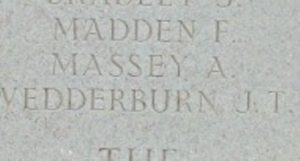
John Samuel Owen, Flight Lieutenant, 90070, Royal Air Force (Auxiliary Air Force). John was born in 1914. He married Mary Cecilia Hope Sparrow, of Treetops, Moel-y-Garth, in 1940. John was already serving as a pilot with the Royal Air Force prior to the war, and had been posted to 504 Squadron, RAF. The squadron had become a fighter squadron on 31 October 1938 and received Hawker Hurricanes in March 1939. A few days before the outbreak of war, the squadron moved to RAF Digby to fly defensive patrols, but in May 1940 moved to France for a short period to cover the BEF. On 18 May 1940 John was flying Hurricane L1912 near Valenciennes in Northern France when he was shot down by a German Me109. He bailed out of his stricken Hurricane, which crashed to the ground, but was reportedly killed in his parachute. The 25-year-old was buried in Cambrai (Route De Solesmes) Communal Cemetery, France. His widow lost a brother, Aylmer Knox Sparrow, in the Mediterranean in 1943.
Brian Percival Purves, Captain, 124152, Hampshire Regiment. Brian was the son of Percival Thomas Purves and Ruby Purves, of Transvaal and London. He married Francis Mary Collinson, of Guilsfield, in 1937. Brian had been commissioned into the 2nd Battalion, Hampshire Regiment in March 1940 but had volunteered to serve with the SOE, Special Operations Executive, a highly skilled unit which had been formed to carry out covert operations behind enemy lines. Little else is known of his service, but he was killed in Italy on 6 March 1945. The 37-year-old is buried in Naples War Cemetery, Italy. Brian is not commemorated on the Guilsfield war memorial.
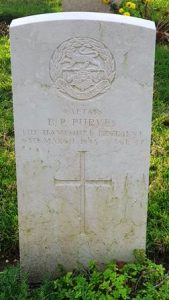
Edward Richards, Fusilier, 4032408, Royal Welch Fusiliers. Edward was the son of John Richards and Mary E. Richards (nee Jones). He married Florence Winifred Beddoes, of Llidiart, Moel-y-Garth in 1935. Edward was a regular soldier and was serving with the Royal Welch Fusiliers when war broke out. Edward was then attached to a unit of the Pioneer Corps and embarked for France with the BEF in 1939. Following the German Blitzkrieg invasion of France and the low countries, the BEF was forced to withdraw towards the safety of the channel coast. The thousands of troops who had made it to Dunkirk had already been evacuated by 6 June, whilst more had been evacuated from Boulogne, Calais and Le Havre by 25 May. Edward’s unit had been forced to withdraw to the port of St. Nazaire, and on 17 June 1940, boarded the requisitioned liner, RMS Lancastria, which had just steamed into the Loire Estuary, before anchoring in the Charpentier Sounds. By the afternoon Lancastria had taken aboard a huge number of evacuees, far greater than she was built to carry, with estimates running from 4,000 to 9,000 people. The Germans had already begun attacking shipping in the area, and at 15.50 Lancastria was attacked by Junkers-88 bombers, sinking in less than 20 minutes. An estimated 6,500 people drowned in the sinking of Lancastria that day. Edward was 26 years old when he died as a result of the sinking of the Lancastria that day. His body was later washed ashore, and he was buried in Pornic War Cemetery, France.
George Richard Gorton Roberts, Captain, 68150, Royal Artillery. George was born at Wrexham on 7 October 1914, the son of Reverend George Ishmael Roberts and Alice Hall Roberts (nee Gorton). His father then took up the post as Vicar of Guilsfield and the family moved to the Vicarage. George was commissioned into the Royal Artillery and had made his way up to Captain before being posted to the 1st Light Anti-Aircraft Regiment, Royal Artillery. On 13 April 1942, George’s regiment was on Salisbury Plain, but he had gone to watch a demonstration of tactical air power. A target area had been laid out on the ground for a number of RAF aircraft to carry out practise attacks and a number of spectators and dignitaries were present. The weather was fine but hazy and one of the aircraft, a Hurricane of 175 Squadron, opened fire with his cannons, missing the target area and hitting a group of spectators, killing or mortally wounding some twenty-five of them. George was seriously wounded during the accident and was taken to hospital at Sturminster where he died of his injuries the following day, 14 April 1942. The remains of the 27-year-old were conveyed back to Guilsfield, and he was buried in Guilsfield Cemetery three days later.
Aylmer Knox Sparrow, Signalman, 2360566, Royal Corps of Signals. Aylmer was born at Nottingham on 15 January 1919, the son of Doctor Henry Hope Knox Sparrow and Mary Olivia Henrietta Sparrow (nee Martin). The family later resided at Treetops, Moel-y-Garth. Aylmer was educated at Nottingham High School before joining King William’s College, where he joined the Officer Training Corps. He was commissioned as a Second Lieutenant into the South Nottinghamshire Hussars, Royal Artillery on 25 March 1939, but later relinquished his commission to become a signaller with the Royal Corps of Signals. He then joined the Small Scale Raiding Force, a precursor of the Special Boat Service, which had been formed from the 1st Special Air Service Regiment in April 1943. The newly formed unit moved to Haifa and trained with the Greek Sacred Regiment for operations in the Aegean, before taking part in operations against German forces in the Dodecanese and Cyclades groups of islands in the Dodecanese Campaign. Aylmer was killed during these operations on 17 November 1943. The 24-year-old has no known grave and is commemorated on the Athens Memorial, Greece. His sister lost her husband, John Samuel Owen, in France in 1940. Aylmer is not commemorated on the Guilsfield war memorial.
